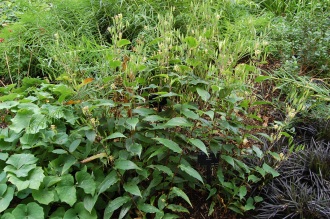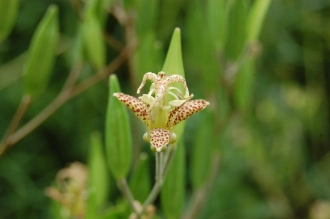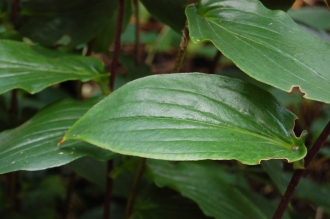Position: Full sun to partial shade
Flowering period: Summer
Soil: Moist, well drained
Eventual Height: 60cm
Eventual Spread: 30cm
Hardiness: 5a, 5b, 6a, 6b, 7a, 7b, 8a, 8b, 9a
Family: Liliaceae
Tricyrtis latifolia is a deciduous herbaceous perennial with a clump forming habit. Its mid to dark green leaves are obovate to ovate-elliptic with undulate margins and has parallel veins. Its stems are arching and unbranched. Its hermaphroditic, yellow with red/ brown spotted flowers are up to 30mm across, and appear in the upper leaf axils. Its roots are rhizomatous which aids its spread.
Tricyrtis latifolia, commonly known as the Toad Lily or Tamagawa Hototogisu, is native to eastern Asia, including Japan, some sources reference this species as also being native to China and reader input would be welcomed. In its native habitat it grows in moist woodlands, shaded cliffs and stream banks. Tricyrtis latifolia is synonymous with Tricyrtis bakeri.
The name Trictyris is derived from the Greek tries meaning ‘three’ and kyrtos meaning ‘convex’, referring to the three out sepals having swollen bases. Latifolia is from the Latin latus meaning ‘broad’ and folium meaning ‘leaf’.
The landscape architect may find Tricyrtis latifolia useful as part of a woodland planting scheme.
Ecologically, Tricyrtis latifolia flowers are attractive to pollinating insects.
Tricyrtis latifolia prefers moist, humus rich, well-drained soils. It tolerates most pH of soil. It will not tolerate alkali soils.
Tricyrtis latifolia requires little maintenance. Large clumps may be divided in spring.
![]()
Landscape Architecture










